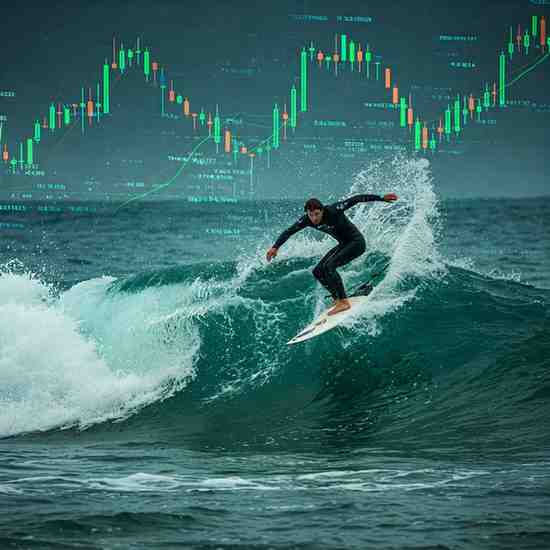
What is Riding the Wave in Trading?
What is Riding the Wave in Trading?
“Riding the wave” in the financial markets refers to a trend-following trading approach, where traders aim to profit by capitalizing on the momentum of prevailing market trends. This strategy hinges on the principle that trends, once established, are likely to continue for a certain period. Momentum, the speed and strength of price movements, plays a crucial role in identifying and validating these trends. This blog aims to provide intermediate to advanced traders with a comprehensive understanding of the mechanics and considerations involved in riding the wave, a relevant strategy within the dynamic landscape of the stock market.
Understanding Trend-Based Trading
Trend-based trading is rooted in the idea that markets move in discernible trends. These trends can be classified as uptrends (characterized by higher highs and higher lows), downtrends (lower highs and lower lows), or sideways trends (lack of clear direction). Identifying and confirming these trends is paramount before initiating a trade. This involves analyzing price action and volume to validate the trend’s strength. The duration of a trend can vary, impacting trading decisions. Short-term trends may require quick entries and exits, while long-term trends allow for more extended positions. Confirming trend strength with volume analysis is essential; rising volume during an uptrend, for instance, reinforces its validity.
The Role of Momentum Traders
Momentum traders are individuals who seek to profit from the velocity of price movements. They capitalize on rapid price changes and high trading volume, aiming to enter trades when momentum is strong and exit before it fades. The psychology behind momentum trading is driven by market sentiment, which can fuel rapid price swings. However, risk management for momentum driven trades is crucial due to the inherent volatility. These traders must employ strict stop-loss orders and position sizing to protect their capital.
Technical Indicators for Wave Identification
Technical indicators are indispensable tools for identifying and confirming trends. Moving averages, such as simple and exponential moving averages, help smooth out price data and identify trend direction. The Relative Strength Index (RSI) measures the speed and change of price movements, indicating overbought or oversold conditions. 1 The Moving Average Convergence Divergence (MACD) identifies changes in the strength, direction, momentum, and duration of a trend. Volume indicators confirm price movements by analyzing trading volume alongside price action. Combining these indicators provides a comprehensive view of market dynamics. Utilizing multiple timeframes for trend confirmation is also vital, as it helps validate signals across different perspectives. For example, a daily chart might show an uptrend, while a shorter timeframe chart could reveal entry points.
Popular Momentum Trading Strategies
Several popular momentum trading strategies exist. Moving average crossover strategies involve buying when a shorter-term moving average crosses above a longer-term moving average and selling when it crosses below. RSI divergence strategies identify potential trend reversals by observing discrepancies between price action and RSI readings. MACD signal line crossover strategies generate buy or sell signals when the MACD line crosses the signal line. Breakout trading strategies capitalize on price breaking through key support or resistance levels. Each strategy has specific entry and exit signals, and traders must adapt them to current market conditions. Adapting trading strategies to market volatility ensures that trading remains effective in different market environments.
Considerations and Cautions
Momentum trading is not without risks. False signals and whipsaws, rapid and unpredictable price reversals, can lead to significant losses. Therefore, robust risk management is essential. This includes using stop-loss orders to limit potential losses and employing proper position sizing to manage risk exposure. Continuous learning and adaptation are crucial, as market conditions constantly evolve. It’s also vital to backtesting trading strategies before real market deployment, ensuring they align with your risk tolerance and trading style.
Conclusion
Riding the wave trading strategy offers a method to capitalize on market trends by leveraging momentum. A disciplined approach, thorough technical analysis, and continuous learning are essential for success. By understanding the mechanics of trend-based trading and employing effective risk management, traders can navigate the markets with greater confidence.
Giga Pro: Your Gateway to Advanced Investing
At Goodwill Wealth Management, we understand that experienced as well as new investors demand more than just the basics. That’s why we created Giga Pro, a mobile trading app designed to fuel your investment journey. Download the app today to start your trading journey on your Android device: (Download GigaPro Mobile App) or on your Apple device: (Download GigaPro Mobile App)
Disclaimer: This blog post is intended for informational purposes only and should not be considered financial advice. The financial data presented is subject to change over time, and the securities mentioned are examples only and do not constitute investment recommendations. Always conduct thorough research and consult with a qualified financial advisor before making any investment decisions.
